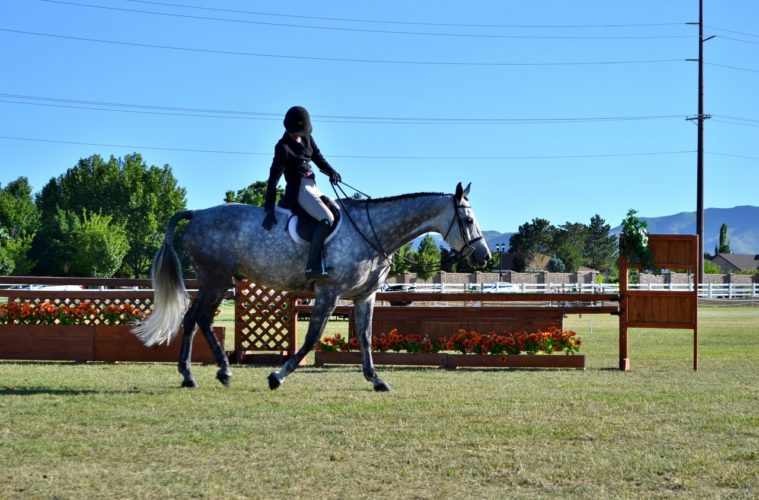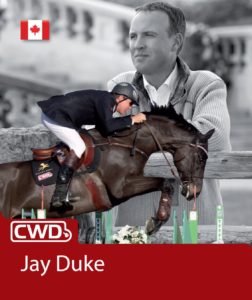The sport of show jumping has changed and evolved in the past 30 years. Many of the changes have been positive and good for the sport, others not so much. Today’s discussion looks at the evolution of the hunter divisions in North America, and what it means to equestrian sport.
I began showing on the A circuit at the age of 8. It was 1977 and I was competing at Spruce Meadows in Calgary, Canada on my pony. She was a 14.1hh quarter horse mare. Ponies of all heights showed in the same class, and there were 45 entries in the class. The height of the fences was 3′ and the ring was 10 acres in size, with level ground being nothing but a myth and something to be scorned as too easy. The fences consisted of natural style jumps, no plastic flowers in sight. There was a stone wall (you can still see it outside of the Meadows on the Green ring), a dry ditch, a road jump, and for the horses a liverpool. It wasn’t plastic, it had real water in it.
Everything from the breed of my pony to the number of entries to the ring was different than anything you see in North America today. The height of the ‘large’ pony division was lowered to 2’9 in 2015, but that is a topic for another day. This is about the history of hunters, and I have described this to illustrate the changes in the hunter ring today. The Regular Hunter division was built to 4’6,( 1.38m.) There were not many entries in it, but there was more than there is today in the Regular division where the jumps are 4′ (1.20m).
In the early 90s two major changes happened that greatly changed the show jumping world. First, horse show managers were looking to expand the number of horse shows and the number of participants at their shows. Running horse shows was starting to be seen as a good business opportunity. Second, more and more young riders were turning professional and making a career of horses.
The degree of difficulty of the fences and courses was lessened. More divisions were added to attract more riders of lesser experience and ability. The hunters evolved into side/diagonal/side courses in 100’ x 200′ rectangular rings. The hunter horse divisions, which started in height at 3’6 (1.08m) devolved into 2’9, then 2’3, and now we have crossrails. One of my coaches used to lament this fact, saying that soon there would be subterranean hunters, that they would dig a hole in the ground and throw a pole in it. This was an excellent move by the horse show managers. The number of horses at the shows increased exponentially. Large A circuit shows went from averaging 300 horses to over 800 horses.
In the early 2000s, some of the top professionals in the USA got together and discussed the state of the sport. They strove to bring back the challenge of riding in the hunter ring, and to make the hunters a sport that spectators would want to watch again. The Hunter Derby was created.
The derby brought back the use of natural jumps. It got rid of the side/diagonal/side pattern which still dominates the hunter ring. It rewarded creativity and riders willing to take risks. Scores were announced after each round, engaging the spectators. (Really, what judged sport doesn’t give scores other than show hunters, ridiculous).
Probably most important it showcased horses that actually jumped, as opposed to just flopping over the jumps. One more important point: the jumps were 3’6 with options up to 4’3 (1.10m-1.30m). The hunter derby became fun to watch again, it created interest in the sport, and it created a niche for many talented horses that were not being used to their best abilities.
So the creation and development of the hunter derby has been a positive for the sport of show jumping, except for one little problem. Horse show managers saw an opportunity for more profit, and have in many cases lowered the heights and degree of difficulty of the derby. The class that was designed to raise the level of riding, of horsemanship, of actual talent has been dumbed down. Again. Just like the hunter division was 20 years ago. It was designed to raise the level of riding, to force trainers to buy better horses, to train those horses to a more educated level. The derby concept was a success, but not nearly to the degree it was capable of being.
Now some of you may be thinking that I am being unfair to the developing horse and rider. The opposite is true. It is imperative, for the sport to develop, to create incentive for horse and rider to improve. To reach, train, push for, and achieve the best that you can. It doesn’t matter what level that horse or rider actually make it to, what is important is that both develop to their full potential. I think that many horse shows should have 3′ (.90m) level derbies. They are important for the inexperienced horse and rider.
However, they should not be a featured class. Lets say a horse show has 2 derbies scheduled. Instead of holding one on Thursday evening with $2,500 in prize money set at 3′ with 3’3 options, and the 3’6 derby on Saturday evening with $5000 up, do it this way. The big derby has a feature time and ring, second only to the Grand Prix. Take the same money you have and put it into this class, in this example $7,500. Promote it, make it a big class. The winners should be recognized. Then run the 3′ derby on Sunday morning in ring 5 with no prize money. It’s a training class, one that should be used so horse and rider can enter the feature class. There must be incentive provided to attain new heights, and the show managers have the power to do this.
I implore the show jumping community, and in this case specifically the hunter trainers, riders, and show managers to push for development in the sport. The hunter derby has been an excellent addition to a part of the sport that was floundering. Lets take a great concept and do everything we can to make it even better.
About Jay Duke: Jay has been a Canadian Equestrian team member, and has represented his country at shows in Washington, New York, and Toronto. He’s been the leading rider at the Spruce Meadows North American Championships, trained notable hunter and USEF horses such as Mindful, King David, and Caymus, and coached two riders to medal-winning performances at the NAJYRC. He is also a senior course designer with Equestrian Canada and offers clinic opportunities around the world. You can read more work from Jay Duke at his website, jayduke.com


